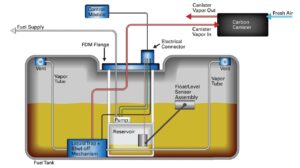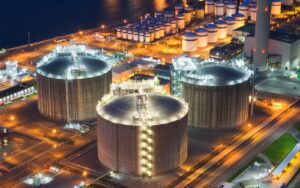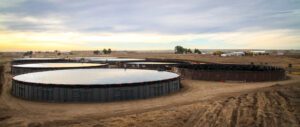Ever wonder what those big metal tanks are that you pass by on the highway or see behind industrial buildings? Chances are they’re aboveground storage tanks holding chemicals or fuel. As essential as these tanks are for storage and transport, they do come with risks like emissions, fires, and explosions if not properly vented and maintained. Fuel Storage Tank Venting solutions are making aboveground storage tanks safer and more environmentally friendly.
These innovative technologies reduce emissions, prevent over-pressurization, and mitigate risks like sparks igniting flammable fumes. Sounds pretty important, right? If you’re an operator, regulator, or live or work near aboveground storage tanks, you’ll want to keep reading to find out how the latest advanced venting solutions can increase safety, tighten emissions control, and give you greater peace of mind. The technology behind these advanced systems may be complex, but their benefits are easy to understand.
Why are Fuel Tanks Vented
ANy petrochemical or gasoline storage tank venting is crucial for aboveground storage tanks (ASTs) to operate safely and efficiently. Inadequate venting can lead to dangerous pressure buildup, emissions leaks, and even tank ruptures.
Why is Venting Important
Venting allows pressure to be released from ASTs as the level of stored liquid changes. As the product is pumped in or out, the empty space in the tank (known as headspace) must be able to properly vent to prevent pressure spikes. Controlled venting also allows tank emissions to be captured, reducing pollution and ensuring compliance with environmental regulations.
If pressure is not properly vented, it can build up to dangerous levels and potentially cause tank damage or rupturing. Over-pressurization often happens during filling operations if the inlet flow rate exceeds the venting capacity. It’s also a risk if vents become clogged or malfunction.
Equally problematic is under-pressurization, which can lead to structural damage from vacuum stress and suck air contaminants into the tank. Under-pressurization frequently occurs during product withdrawal if the outlet flow rate exceeds the venting capacity.
Importance of Emissions Control System
Proper venting solutions help capture tank emissions, especially volatile organic compounds (VOCs), and route them to pollution control systems like vapor recovery units, thermal oxidizers, or carbon adsorption systems. This prevents harmful pollutants from escaping into the atmosphere and reduces health risks to workers and surrounding communities.
Emissions control is mandated for many industries by federal, state, and local regulations. Advanced venting systems help AST owners and operators meet requirements for safety, environmental protection, and regulatory compliance. With the right venting in place, you can have peace of mind that your tanks are operating as intended and your facility is a good environmental steward.
Advanced Vent Designs for Enhanced Safety
Advanced venting systems are key to safe AST operation and emissions control. Standard vents just don’t cut it anymore. You need vents engineered for high performance, like pressure/vacuum vents, flame arresters, and vapor recovery units.
Pressure/vacuum vents automatically relieve excess pressure or vacuum in the tank to prevent structural damage. They’re a must for volatile chemicals. Flame arresters prevent fire or explosion by stopping flame transmission into the tank. They contain flame quenching devices that extinguish flames passing through the vent.
Vapor recovery units (VRUs) capture and recover chemical vapors displaced during filling and emptying. They significantly reduce emissions and can recover up to 95% of vapors. VRUs typically use carbon adsorption or refrigeration to condense vapors. The recovered product can then be reused, cutting waste and costs.
Emissions monitoring systems
Emissions monitoring systems constantly sample the air around ASTs to detect vapor leaks or releases. They can monitor for volatile organic compounds (VOCs), toxic gasses like benzene, and combustible gasses. Monitoring systems alert operators to emissions events so action can be taken quickly to avoid safety or environmental incidents.
Advanced venting solutions do require an investment, but the rewards are well worth it. Fewer emissions mean a greener operation and lower regulatory burden. And enhanced safety systems give you peace of mind that your ASTs are as protected as possible from risks like over-pressurization, vacuum collapse, fires, and explosions. When it comes to your operation, safety and sustainability should be top priorities. Advanced vents provide the technology to achieve both.
Conservation Vents: Maximizing Product Retention and Minimising Emissions
Conservation vents are designed to maximize product retention in storage tanks while minimizing emissions. These specialized vents regulate pressure to an optimal range for the specific material being stored.
How Does a Conservation Vent Work
Conservation vents relieve excess pressure from the tank in a controlled manner. As the temperature in the tank rises, pressure also builds. The vent will open to release enough vapor to reduce pressure to the target range, then close again to contain remaining emissions. This on-demand venting reduces total emissions compared to standard vents that remain open.
Conservation vents use a variety of mechanisms to control venting:
- Weighted pallets – Place weighted plates over the vent opening. As pressure builds, the weight is pushed up to open the vent. When pressure reduces, the weight closes the vent again.
- Spring-loaded vents – A spring applies pressure to keep the vent closed. As tank pressure increases, it pushes open the vent against the spring force. The spring then closes the vent once pressure lowers.
- Pilot-operated vents – A pilot valve senses tank pressure and opens or closes the main vent valve as needed to stay within the set range. These electronic vents can be very precisely controlled.
Proper sizing and calibration of conservation vents is key to their effectiveness. Venting requirements depend on factors like stored material, tank dimensions, temperature, and other environmental variables. Consult an expert to determine appropriate vent sizing and settings for your specific application.
When used properly, conservation vents can achieve emission reductions of 90% or more compared to standard pressure relief vents. For facilities handling large volumes of volatile organic compounds (VOCs) or hazardous air pollutants (HAPs), the lowered emissions can help achieve compliance with air quality regulations. Conservation vents maximize product retention, minimize pollution, and improve safety – a win-win for the environment and the bottom line.
Flame and Detonation Arresters: Preventing Catastrophic Tank Failures
Flame and detonation arresters are critical safety mechanisms for aboveground storage tanks that help prevent catastrophic tank failures. As flammable vapors can build up in the tank headspace, the arrester allows tank venting while stopping any flames from entering the tank.
How Flame Arresters Work?
Flame arresters contain small passages that the vapors can flow through, but that are too small for flames to pass. As the flammable vapors exit the tank through the normal vent, the flame arrester stops any outside flames from entering the tank. The arrester absorbs the energy and extinguishes the flame, preventing it from igniting the flammable vapors inside the tank.
Detonation arresters also contain flame-quenching mechanisms but are designed to prevent more powerful detonation flames from entering the tank. For tanks storing highly volatile substances like LPG, a detonation arrester may be required.
Choosing the Right Flame Arrester
Several factors determine which type of flame arrester is right for your storage tank:
- The flammability and volatility of the stored product. More volatile substances require an arrester that can quench more powerful flames and detonations.
- The size and type of the storage tank venting system. The arrester must be properly sized and rated for the venting system to work effectively.
- Operating temperatures and pressures. The arrester material must be compatible with the temperatures and pressures inside the tank.
- Compliance with industry standards. Flame arresters must meet strict safety standards for performance to properly protect aboveground storage tanks.
- Ease of inspection and maintenance. Choose an arrester that allows for easy visual inspections and parts that can be serviced to ensure optimal performance.
Following best practices for flame and detonation arrester selection and installation helps ensure your aboveground storage tanks have advanced venting solutions for maximum safety, emissions control, and regulatory compliance. With the right arrester in place, you can have peace of mind that your storage tanks are protected from the threat of catastrophic failure.

FAQs: Answers to Common Questions About AST Venting
You probably have a few questions about advanced venting solutions for your aboveground storage tanks. Here are some of the most common FAQs and answers:
What are the benefits of upgrading my AST venting system?
Upgrading to an advanced venting solution offers many benefits:
- Improved safety. Advanced vents help prevent over-pressurization and vacuum collapse, reducing the risks of fire, explosion or tank damage.
- Lower emissions. Advanced vents capture and control emissions of volatile organic compounds (VOCs), hazardous air pollutants (HAPs) and other gasses to comply with environmental regulations.
- Cost savings. Although upgrading has initial costs, advanced vents can save money in the long run through improved efficiency, reduced product loss, and avoided fines for non-compliance.
What types of advanced vents are available?
The main options for AST venting include:
- Pressure/vacuum relief vents: Control tank pressure and prevent vacuum collapse. Can include flame arresters to prevent fire and explosion.
- Conservation vents: Minimize emissions during normal operation while still preventing over-pressurization.
- Vapor recovery units: Recover vapors for processing or sale. Provide the highest level of emission control.
How difficult is it to upgrade my existing venting system?
Upgrading is usually straightforward and minimally disruptive. Advanced vents are designed to mate directly to standard tank fittings, so no major retrofitting is required in most cases. If additional piping or supports are needed, installation only requires basic skills and tools. However, some local regulations may apply regarding installation, emissions, permitting, and other factors, so check with authorities before upgrading.
Do advanced vents require ongoing maintenance?
Advanced vents are low-maintenance. Key steps include:
- Inspecting vents periodically to ensure proper operation.
- Replacing worn or damaged parts like seals, filters and flame arresters.
- Monitoring and emptying collection points for any recovered vapors.
- Performing any required testing to ensure compliance.
- Keeping records of maintenance, testing and any repairs.
Following the vent manufacturer’s recommendations for maintenance and part replacement will keep your advanced venting system running safely and efficiently for years. Please let me know if you have any other questions!
Conclusion
So there you have it, some of the latest and greatest methods for enhancing safety and reducing emissions from your aboveground storage tanks. Technology and best practices have come a long way to give you affordable, efficient options to choose from. Whether you need a basic pressure/vacuum relief valve or want to take your operation to the next level with a closed-loop vapor recovery system, the venting solutions are out there. Stay on top of the options, consider your needs and budget, and make the investments that will benefit your operations and community for years to come. Your workers, neighbours, and the planet will thank you.





